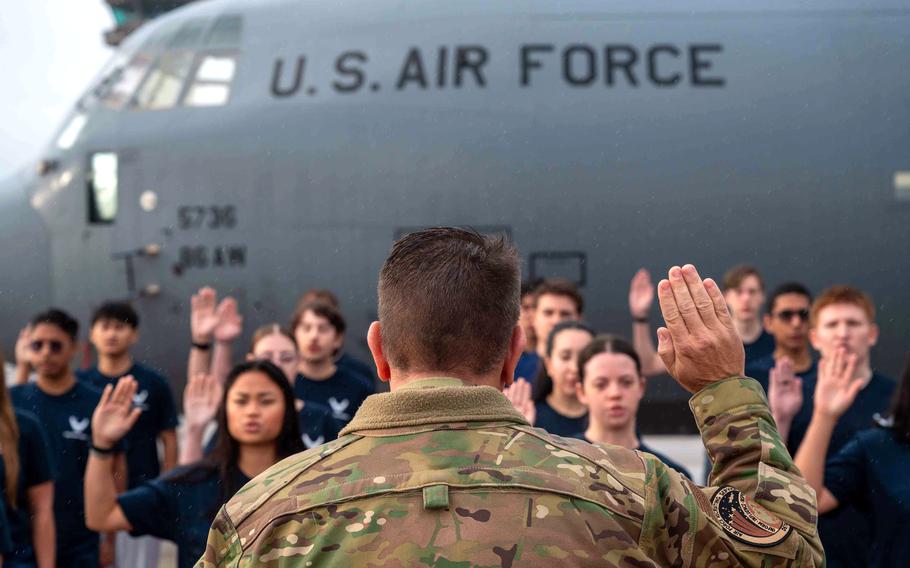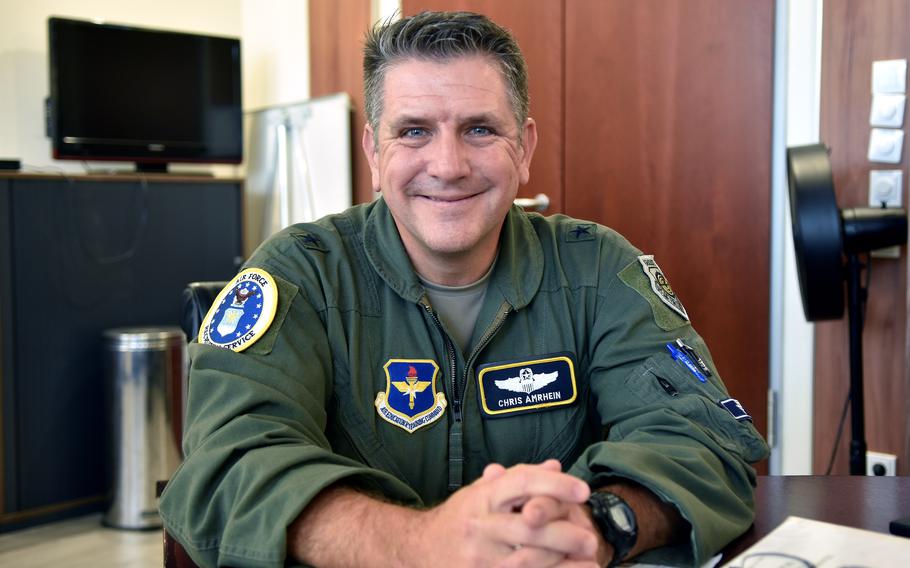
Brig. Gen. Christopher Amrhein, commander of the Air Force Recruiting Service, swears in new recruits at Ramstein Air Base, Germany, on Sept. 12, 2024. (Dylan Myers/U.S. Air Force)
The Air Force is on track to meet or exceed its annual recruiting goal a year after experiencing a dismal 10% shortfall in new active-duty enlistments, according to the service’s recruiting leader.
As of last week, fiscal 2024 active-duty recruitment numbers were at “25,000 and change,” said Brig. Gen. Christopher Amrhein, commander of the Air Force Recruiting Service.
The current tally already tops the 24,100 who entered the active force in 2023, when the target was 26,877, according to Pentagon data.
Even with the target elevated this year to 27,100, all signs point toward achievement of that goal, Amrhein said Thursday, with just over two weeks left in the fiscal year.

Brig. Gen. Christopher Amrhein, commander of the Air Force Recruiting Service, visits Ramstein Air Base, Germany, on Sept. 12, 2024. Ramstein is one of several bases in Europe where Air Force recruiters are assigned. (Jennifer H. Svan/Stars and Stripes)
“It wasn’t any one thing,” he said. “It was a lot of levers being worked in combination to each other, which really gave our recruiters the tools they needed … to find the talent to come into our service.”
Amrhein and his senior enlisted leader, Chief Master Sgt. Rebecca A.C. Arbona, were at Ramstein Air Base in Germany on Thursday as part of an overseas visit to several European bases where the command has a handful of recruiters assigned.
The reserve and Air National Guard are also having banner years, he said, after missing the mark by more than 30% last year.
While at Ramstein, Amrhein swore in 16 new recruits at a ceremony on the flight line next to a C-130J cargo plane. One of the recruits, a 40-year-old, was eligible because last fall, the service raised the maximum enlistment age from 39 to 42. An airman has to be at basic military training before turning 42, service officials said.
Raising the maximum enlisted age is just one of many factors that turned around Air Force recruiting, Amrhein said.
Last year was a tough one for new enlistment across much of the military, not just for the Air Force. Both the Navy and the Army also fell well short of their objectives. The Pentagon called it the worst recruitment year for services since the inception of the all-volunteer force.
Besides the age limit increase, the Air Force also loosened body fat restrictions last year, bringing them in line with Navy and Army standards.
The raised threshold of 26% fat for men and 36% for women, up from 20% and 28% respectively, allowed the service to bring in an additional 3,000 active-duty recruits, or 5,600 if the reserve and Air National Guard are included, Amrhein said.
Improvements to medical screening also opened up more channels for recruits to serve.
The service was hit hard last year by a backlog of medical waivers, slowing down the review process. The average wait was 12 to 14 days but in some it could take up to three months or more, he said, calling that too long.
As a result, about 8,800 people walked away before their cases were decided, Amrhein said. Based on an Air Force approval rate of about 70% for medical waivers, the loss of those applicants cost the service about 5,600 new airmen last year, he said.
In response, staffing was beefed up and the waiver review process now takes an average of two to three days, Amrhein said.
Another cause of the bottleneck was the rollout of MHS Genesis, the Defense Department’s new electronic health records system, about two years ago.
More recruits are now being flagged for health issues because Genesis captures their entire medical history, from an inhaler prescription to a brief telephone consultation, if it’s on record.
Prior to Genesis, the Air Force reviewed about 10,000 medical waiver requests per year, according to Amrhein, who said that by comparison, “we’re just over 23,000 for this year alone.”
The service now grants automatic waiver approval for six or seven exoskeletal conditions, such as knee pain or shoulder issues, that in the past were approved 85% of the time or more, Amrhein said.
But he was quick to say that the changes have not lowered the caliber of recruits.
“I want to make sure there’s a delineation on what we would consider the qualifications to serve versus meeting a standard,” he said. “When I’m thinking of meeting a standard, I’m thinking, ‘Can they graduate from BMT? Can they continue to serve and do they meet those in-service standards?’ Those we haven’t compromised on.”